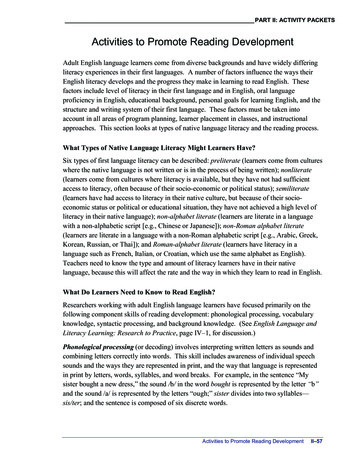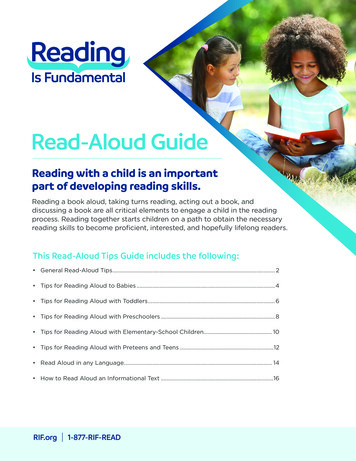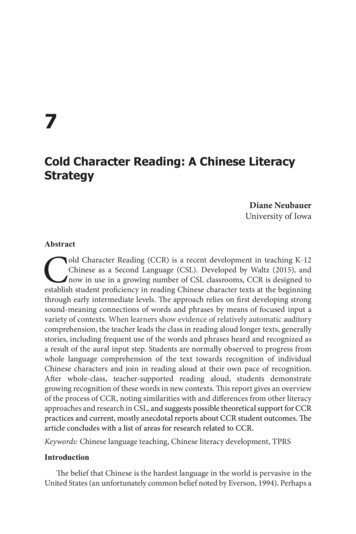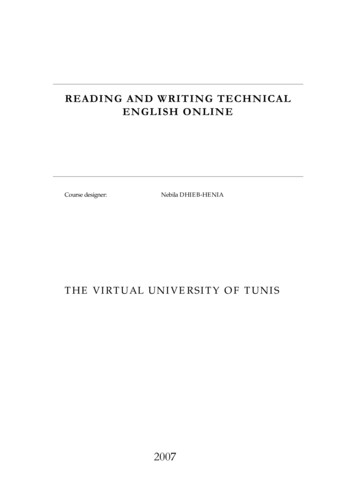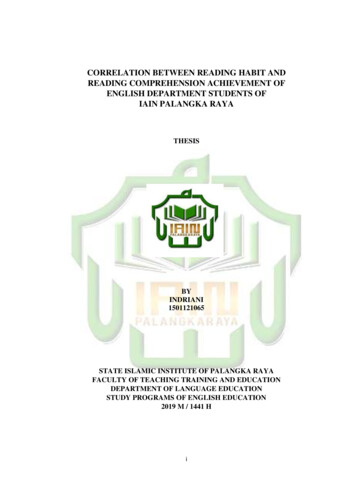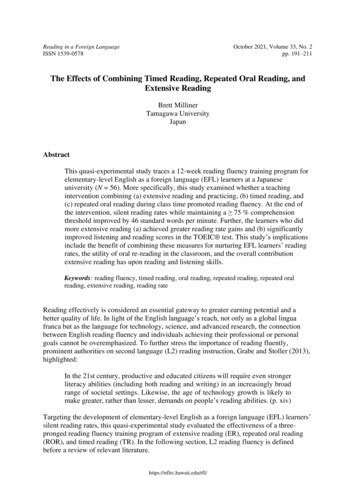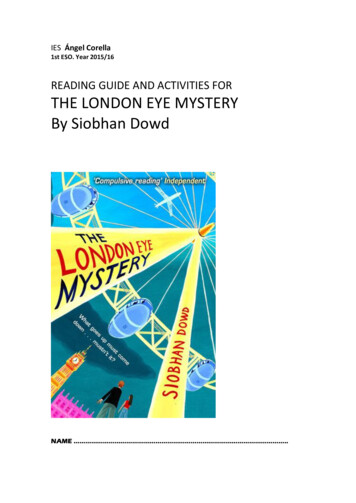
Transcription
IES Ángel Corella1st ESO. Year 2015/16READING GUIDE AND ACTIVITIES FORTHE LONDON EYE MYSTERYBy Siobhan DowdNAME .
PRE- READING ACTIVITIES1. UNDERSTANDING THE STORYREFLECT UPON THE STORYHow would you feel if a relative of yours disappeared in front of your eyes?Have you ever felt different from other people? Why?The genre of this book Mystery Fiction or Detective Fiction, what do you know about thisgenre? Do you know any famous author or character?SYNOPSISWhen Ted and Kat watched their cousin Salim get on board the London Eye, he turned andwaved before getting on. After half an hour it landed and everyone trooped off - but no Salim.Where could he have gone? How on earth could he have disappeared into thin air? Since thepolice are having no luck finding him, Ted and Kat become sleuthing partners. Despite theirprickly relationship, they overcome their differences to follow a trail of clues across London ina desperate bid to find their cousin.TED A UNIQUE AND LIKEABLE CHARACTERTed Spark is the main character in the book. The story is told in the first person, from his pointof view. He tells us early on that he is a little different from other people, that his brain has a“different operating system” than other people. We are not told his age in the story but wecan guess that he is 11 or 12 years old and younger than his sister Kat and his cousin Salim.We see from the very beginning that he is very mathematical and logical in his thinking. Hecounts everything, from his breakfast shreddies to the number of postage stamps needed tocover his front garden. He is fascinated with weather and he wants to be a meteorologistwhen he grows up. He listens to the shipping forecast on B.B.C. radio every night. His room isneat and tidy and full of fact books and encyclopaedia. He is very observant and rememberslittle details other people don’t, such as what people are wearing.He wears his school uniform (trousers, shirt and tie) every day, even weekends and holidays.We are told that he has some “syndrome” or other but not exactly what it is. Perhaps it isAsperger’s Syndrome or perhaps not. The author deliberately doesn’t tell us. Why? Salim saysthat Ted has “Some weird syndrome that made him think like a giant computer”. He also tellsus about some physical symptoms: he gets “shakes” in his right arm and hand and a strangefeeling in his oesophagus (food-pipe to stomach) especially when he is scared, nervous orexcited.However, it is other people who are his biggest problem. He finds it difficult to relate withpeople socially. Ted treats everything in the same way. literally, logically, and at face value.He doesn’t fully understand the complexity and subtlety of human relationships. He finds itdifficult to read a person’s facial signals and body language, something his sister doesnaturally. For Ted people “just look like who they are”. He also doesn’t quite understand hisfeelings and emotions. He says he has only one friend, Mr. Shephard, his teacher. Mr.Shephard is working to teach Ted about people and emotions.Language is also a challenge for Ted. He listens to people speaking and takes things“literally”. But people often use images, or old expressions, or slang words when talking.When Ted hears expressions like ‘raining cats and dogs’ or speak of the devil’, he thinksliterally of cats and dogs and devils. His dad teaches him how to decipher language. We learnthat everyday language is full of such ‘non-logical’ talk.
He is a very likeable character who grows up a lot during the course of the big adventure.Again, the story is written in the first person. However we don’t ever feel that we are insidethe mind of someone weird, odd, disabled or handicapped in any way. In fact we enjoy thejourney with all its logical and mathematical observations. We enjoy Ted’s non-sense ofhumour and his literal understanding of words and language. We enjoy the way Ted sees theworld through logical eyes and we learn that he is not odd or strange but unique and talented.2. ANALYSING THE STORYFROM CHAPTER 1 TO CHAPTER 7FROM A GIANT BICYCLE WHEEL IN THE SKY TO THE WHEEL TURNSCHAPTER 11. On what date and at what time did Salim board The London Eye?2. What two London landmarks does Ted mention?3. Do you believe that Salim ran away and was kidnapped or was he just lost? What in the textmakes you think this?CHAPTER 21. This chapter starts with a flashback (going back in time). Explain it2. What does A.W.O.L. stand for? What does it refer to?3. What is “Barrington Heights”? Remember this name because it is going very important forthe denouement of the story4. Can you find any paragraph in this chapter in which Ted literally understands things said byother members of his family?
CHAPTER 3.1. Compare the two versions of the letter about their Aunt GloriaCHAPTER 41. How does Ted describe his Aunt Glory and his cousin Salim?2. On page 31, Ted describes himself. What does he call himself? Copy the quotation from thebook and say why he compares himself to Andy Warhol. Find a picture of Andy Warhol onInternet, if possible glue it here. Who was he?WORKING WITH WORDSSometimes the way characters say things is not the same every single time. So the narratoruses verb such as mutter, shriek, mumble or giggle to emphasize the emotions of thecharacters and the tone of their words. Some other expressions would refer to body language,such as nod or blink at. Let’s translate some of them:- Hiss- giggle- whisper- Squeak- mutter- Screech- mumble- Grunt- moan- Gasp- scream- Sigh- reply- Groan- chuckleBody language- Shrug- blink at- Nod- strokeCHAPTER FIVE1. What do Salim and Ted have in common?2. Explain the meaning of the expression “ a cool dude”
CHAPTER SIX AND SEVEN1. What is a topological map?2. Name the London landmarks appearing in chapter 6.3. How did Salim get a free ticket?4. Go to page 55 and find 4 synonyms for the expressing to drive someone bananasFROM CHAPTER 8 TO CHAPTER 14FROM WHAT GOES UP DOESN’T NECESSARILY COME DOWN TO EIGHTTHEORIESCHAPTER 81. Record emotions and questions that might be rushing through children’s minds after Salimdisappears.CHAPTER 92. Why is Ted talking about dodos, lords and brigantines in chapter 9?3. At the end of chapter 9 Ted feels very pleased with Kat. Why? Find the quotation in the bookto justify it.CHAPTER 114. Explain the expression you could have cut the atmosphere with a knife5. What was the name of the Detective in charge of the case?
6. Fill in this report as if you were Detective Inspector Pearce
CHAPTER 148. Which of the nine theories mentioned in the book makes the most sense to you? Why doesthat one make more sense than the others?FROM CHAPTER 15 TO CHAPTER 18FROM INFINITY TO THE NINTH THEORY1. Chapter 15 is one of the most tense, sad and touching chapter so far. Explain why.CHAPTER 16.2. Explain Kat’s plans. What does Ted think about them? Are they successful at the end?CHAPTER 18.3. On page 147, Ted talks about body language. What does he say about it? What does thisparagraph show up about him?FROM CHAPTER 19 TO CHAPTER 25FROM THE BOY ON THE TRAIN TO THE TV CREWCHAPTER 191. Why does Inspector Pearce say to Ted “if only some of my officers had half of yourbrains”?CHAPTER 202. Explain the meaning of the word eavesdropping. What is the relation of the title of thechapter and what is going on in this part of the story?
From chapter 21 to chapter 24, Ted and Kat find out a very important clue which will get themcloser to Salim’s disappearance.Draw a timeline from the first moment they see it in the printed photo till they decipher themeaning of the letters.FROM CHAPTER 25 TO CHAPTER 30FROM THE TV CREW TO THE ROAD TO NOWHERECHAPTER 251. How has Ted changed from the beginning of the story?2. What is the first lie Ted tells his mum? Why does he do it?CHAPTER 261. According to Ted’s explanation, what is the Coriolis Effect? Explain it briefly with yourown words. What do you think is the relation between this effect and Salim’sdisappearance?2. Why does he talk about Sherlock Holmes on page 209? What is a train of thought?CHAPTER 277. What was the weather like when Ted got the Motorcycle Show?8. What does Ted mean by “her eyes and mouth were wide and round like three flyingsaucers? (page 218)
CHAPTER 299. What three scenes do Ted and Kat watch in the 18 TV screens at the television shop?CHAPTER 3010. Christy is suspicious of having some information. What do you think it is?FROM CHAPTER 31 TO CHAPTER 33FROM TORNADO TOUCHDOWN TIME TO THE SOUND OF THE STORM1. When and where does Ted find out how Salim has vanished?2. Now quote the paragraph in which he expresses it using weather metaphors ( page 249)3. Why does Ted call Inspector Pearce? What has he tried to do before calling her?4. At this point of the story, Ted is doing his best with language and its interpretations ofreality and he uses more and more metaphors as the story continues. Explain the meaningof the following metaphor he uses on page 250. ‘When you try to talk to people in themiddle of a storm, they can’t hear. They can’t catch your words for the sound of the storm’FROM CHAPTER 34 TO CHAPTER 37FROM SMOKE TO SALIM SUPREMECHAPTER 341. Why does Ted’s father say Houston Calling Planet Pluto?2. Ted’s explanation confirms that his theory was right. But in which particularmoment something went wrong?
CHAPTER 37.MARCUS’ STATEMENT1. Who is Marcus? What do we know about his family according to his statement?2. Why did Salim change his life at school?3. Where did they pick up the clothes they used in the Eye?4. Why did Salim change his mind about going to Manchester?5. Where Did Marcus last see Salim?6. Describe and list the different emotions Marcus feels in his narration of the events.7. Why is the camera an essential element to track where Salim is?8. Where had the employee Jacky Winter been for a couple of minutes? What happenedto him?9. Which are the three lies Ted has told throughout the story?1.2.3.
The genre of this book Mystery Fiction or Detective Fiction, what do you know about this genre? Do you know any famous author or character? SYNOPSIS When Ted and Kat watched their cousin Salim get on board the London Eye, he turned and waved before getting on. After half a




